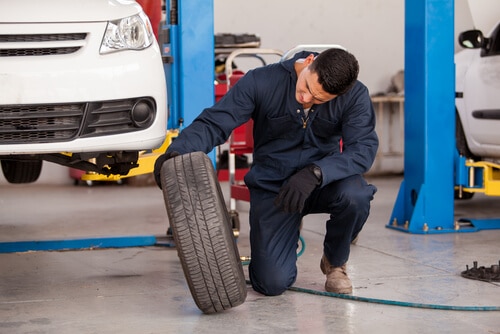If you’ve ever stopped in at a mechanic’s for a quick oil change, the chances are you were also offered a tire rotation with services.
As many people want to be in and out when it comes to waiting on vehicle maintenance, it’s unsurprising that some drivers skip tire rotations and drive their tires into uneven tread wear and danger.
Tire rotation is a vital maintenance need for any vehicle. Here’s why you should prioritize tire rotation service every 5,00 miles or six months.
What is Tire Rotation?
Tire rotation is the process of periodically changing the position of tires on a vehicle. It involves moving each tire from its original location to a different position, such as diagonally swapping front tires with rear tires or diagonally changing their positions.
How a mechanic rotates your tires is based on your vehicle type, tire type, and general wear on your tires.
So, why rotate your tires in the first place? The answer is pretty simple. If you don’t rotate your tires, uneven distribution from the weight of your vehicle and unpredictable road conditions can result in uneven tread wear.
When your tires wear at different rates, you can experience decreased fuel efficiency, poor tire performance, and worst of all, premature tire replacements.
How Do Tire Rotation Patterns Come Into Play?
Tire rotation patterns are based on your vehicle’s drivetrain, tire type, and manufacturer recommendations.
Four of the most common rotation patterns include the following:
Front-to-Back (or Rearward) Rotation
Whether your ride is front or rear-wheel drive, this is one of the most common rotation patterns that will keep your tire tread effective longer.
For front-wheel drive, service providers move the front tires straight back to the rear axle while the rear tires are crossed and moved to the front axle.
For rear-wheel drive, the rear tires are moved straight forward to the front axle, while the front tires are crossed and moved to the rear axle.
This pattern is effective because it moves each tire to the opposite axle and promotes the most even distribution possible.
Cross Rotation (or X-Pattern):
If your vehicle has symmetrical or non-directional tires, this pattern rotates front-to-rear and side-to-side tires.
During this process, the front left tire is moved to the rear right axle, and the front right tire is moved to the rear left axle.
The rear tires are moved straight forward to the front axle, with the rear left tire going to the front left and the rear right tire going to the front right.
Side-to-Side Rotation:
Some vehicles have different-sized front and rear tires. This pattern helps maintain the tires on the same side of the vehicle, reducing the risk of directional tire issues.
During a side-to-side rotation, the front left tire is moved to the front right axle, and the rear left tire is moved to the rear right axle.
The front right tire goes to the rear left axle, and the rear right tire goes to the front left axle, promoting even distribution, despite the difference in tire size.
Five-Tire Rotation (for Full-Size Spare):
If your vehicle has a full-size spare, this rotation pattern adds it to the mix.
The spare tire is included in standard four-tire rotation and is placed in the position of the tire that had the least amount of wear.
This allows all five tires to wear evenly and ensures that the spare tire is not neglected.
What Are the Benefits of Tire Rotation?
For being a quick 30 to 45-minute service, tire rotation comes with several benefits beyond avoiding premature tire replacement.
Tire Rotation Enhances Traction and Handling
If you never rotate your tires, you’re only going to face irreparable wear that creates uneven patterns and weakens the grip and traction of your tires.
Reduced traction makes driving in inclement weather a greater risk and can impact tire responsiveness during braking. Essentially, the more worn down your tread is, the higher the likelihood of hydroplaning and getting involved in an accident.
Greater Tire Lifespan
The average tire should last your vehicle between 3 and 5 years. However, this won’t be the case if you fail to schedule regular tire rotation services.
Tire rotation helps reduce excessive wear on your front tires, which experience some of the most wear on the road. Tire rotation balances the distribution of wear across all of your tires and helps you achieve a longer tread life and total longevity, ensuring you receive the most value from your tire investment.
Improved Fuel Efficiency
Did you know that between 35 and 50 percent of the rolling resistance of a tire comes from the tread? With those odds in mind, getting your tires regularly rotated will help even out the rolling resistance amongst your tires.
This means that no one tire is rolling harder than the other and your vehicle reduces drag and improves gas mileage.
When you add tire rotation to your regular services, you’re unknowingly adding on cost savings in fuel efficiency and the need for new tires too early.
Visit Kwik Kar for Fast Tire Rotations
Kwik Kar is one of Texas’s most trusted auto maintenance and repair providers. We have locations spread out across the Lone Star State and can help with everything from simple oil changes and tire rotations to complex repairs.
Our experience and dedication to quality customer service guarantee you’ll drive safer on the road after a pit stop at a Kwik Kar near you.
Contact us today to schedule an appointment or stop in as we always accept “drive-ins.”



